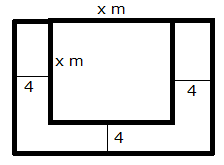The sides of a right-angled triangle containing the right angle are 4x cm and (2x - 1) cm. If the area of the triangle is 30 cm2; calculate the lengths of its sides.

Area of triangle = 30 cm2

But, x cannot be negative, so x = 3.
Thus, we have:
AB = 4 ![]() 3 cm = 12 cm
3 cm = 12 cm
BC = (2 ![]() 3 - 1) cm = 5 cm
3 - 1) cm = 5 cm
CA = ![]() (Using Pythagoras theorem)
(Using Pythagoras theorem)
Hypotenuse = 26 cm
The sum of other two sides is 34 cm.
So, let the other two sides be x cm and (34 - x) cm.
Using Pythagoras theorem,
(26)2 = x2 + (34 - x)2
676 = x2 + x2 + 1156 - 68x
2x2 - 68x + 480 = 0
x2 - 34x + 240 = 0
x2 - 10x - 24x + 240 = 0
x(x - 10) - 24(x - 10) = 0
(x - 10) (x - 24) = 0
x = 10, 24
When x = 10, (34 - x) = 24
When x = 24, (34 - x) = 10
Thus, the lengths the three sides of the right-angled triangle are 10 cm, 24 cm and 26 cm.
(i) the value of x,
(ii) the lengths of its sides,
(iii) its area.
Longer side = Hypotenuse = (3x + 1) cm
Lengths of other two sides are (x - 1) cm and 3x cm.
Using Pythagoras theorem,
(3x + 1)2 = (x - 1)2 + (3x)2
9x2 + 1 + 6x = x2 + 1 - 2x + 9x2
x2 - 8x = 0
x(x - 8) = 0
x = 0, 8
But, if x = 0, then one side = 3x = 0, which is not possible.
So, x = 8
Thus, the lengths of the sides of the triangle are (x - 1) cm = 7 cm, 3x cm = 24 cm and (3x + 1) cm = 25 cm.
Area of the triangle = ![]()
The hypotenuse of a right-angled triangle exceeds one side by 1 cm and the other side by 18 cm; find the lengths of the sides of the triangle.
Let the hypotenuse of a triangle be x cm.
From the given information,
Length of one side = (x - 1) cm
Length of other side = (x - 18) cm
Using Pythagoras theorem,
x2 = (x - 1)2 + (x - 18)2
x2 = x2 + 1 - 2x + x2 + 324 - 36x
x2 - 38x + 325 = 0
x2 - 13x - 25x + 325 = 0
x(x - 13) - 25(x - 13) = 0
(x - 13) (x - 25) = 0
x = 13, 25
When x = 13, x - 18 = 13 - 18 = -5, which being negative, is not possible.
So, x = 25
Thus, the lengths of the sides of the triangle are x = 25 cm, (x - 1) = 24 cm and (x - 18) = 7 cm.

Let the shorter side be x m.
Length of the other side = (x + 30) m
Length of hypotenuse = (x + 60) m
Using Pythagoras theorem,
(x + 60)2 = x2 + (x + 30)2
x2 + 3600 + 120x = x2 + x2 + 900 + 60x
x2 - 60x - 2700 = 0
x2 - 90x + 30x - 2700 = 0
x(x - 90) + 30(x - 90) = 0
(x - 90) (x + 30) = 0
x = 90, -30
But, x cannot be negative. So, x = 90.
Thus, the sides of the rectangle are 90 m and (90 + 30) m = 120 m.
Let the length and the breadth of the rectangle be x m and y m.
Perimeter = 2(x + y) m
![]() 104 = 2(x + y)
104 = 2(x + y)
x + y = 52
y = 52 - x
Area = 640 m2
![]() xy = 640
xy = 640
x(52 - x) = 640
x2 - 52x + 640 = 0
x2 - 32x - 20x + 640 = 0
x(x - 32) - 20 (x - 32) = 0
(x - 32) (x - 20) = 0
x = 32, 20
When x = 32, y = 52 - 32 = 20
When x = 20, y = 52 - 20 = 32
Thus, the length and breadth of the rectangle are 32 m and 20 m.
Let w be the width of the footpath.

Area of the path = Area of outer rectangle - Area of inner rectangle
![]() 208 = (32)(24) - (32 - 2w)(24 - 2w)
208 = (32)(24) - (32 - 2w)(24 - 2w)
208 = 768 - 768 + 64w + 48w - 4w2
4w2 - 112w + 208 = 0
w2 - 28w + 52 = 0
w2 - 26w - 2w + 52 = 0
w(w - 26) - 2(w - 26) = 0
(w - 26) (w - 2) = 0
w = 26, 2
If w = 26, then breadth of inner rectangle = (24 - 52) m = -28 m, which is not possible.
Hence, the width of the footpath is 2 m.
Given that, two squares have sides x cm and (x + 4) cm.
Sum of their area = 656 cm2
![]() x2 + (x + 4)2 = 656
x2 + (x + 4)2 = 656
x2 + x2 + 16 + 8x = 656
2x2 + 8x - 640 = 0
x2 + 4x - 320 = 0
x2 + 20x - 16x - 320 = 0
x(x + 20) - 16(x + 20) = 0
(x + 20) (x - 16) = 0
x = -20, 16
But, x being side, cannot be negative.
So, x = 16
Thus, the sides of the two squares are 16 cm and 20 cm.
Let the width of the gravel path be w m.
Length of the rectangular field = 50 m
Breadth of the rectangular field = 40 m
Let the length and breadth of the flower bed be x m and y m respectively.
Therefore, we have:
x + 2w = 50 ... (1)
y + 2w = 40 ... (2)
Also, area of rectangular field = 50 m ![]() 40 m = 2000 m2
40 m = 2000 m2
Area of the flower bed = xy m2
Area of gravel path = Area of rectangular field - Area of flower bed = (2000 - xy) m2
Cost of laying flower bed + Gravel path = Area x cost of laying per sq. m
![]() 52000 = 30
52000 = 30 ![]() xy + 20
xy + 20 ![]() (2000 - xy)
(2000 - xy)
52000 = 10xy + 40000
xy = 1200
Using (1) and (2), we have:
(50 - 2w) (40 - 2w) = 1200
2000 - 180w + 4w2 = 1200
4w2 - 180w + 800 = 0
w2 - 45w + 200 = 0
w2 - 5w - 40w + 200 = 0
w(w - 5) - 40(w - 5) = 0
(w - 5) (w - 40) = 0
w = 5, 40
If w = 40, then x = 50 - 2w = -30, which is not possible.
Thus, the width of the gravel path is 5 m.
Let the size of the larger tiles be x cm.
Area of larger tiles = x2 cm2
Number of larger tiles required to pave an area is 128.
So, the area needed to be paved = 128 x2 cm2 .... (1)
Size of smaller tiles = (x - 2)cm
Area of smaller tiles = (x - 2)2 cm2
Number of larger tiles required to pave an area is 200.
So, the area needed to be paved = 200 (x - 2)2 cm2 .... (2)
Therefore, from (1) and (2), we have:
128 x2 = 200 (x - 2)2
128 x2 = 200x2 + 800 - 800x
72x2 - 800x + 800 = 0
9x2 - 100x + 100 = 0
9x2 - 90x - 10x + 100 = 0
9x(x - 10) - 10(x - 10) = 0
(x - 10)(9x - 10) = 0
x = 10, ![]()
If ![]() , then
, then ![]() , which is not possible.
, which is not possible.
Hence, the size of the larger tiles is 10 cm.
Let the length and breadth of the rectangular sheep pen be x and y respectively.
From the given information,
x + y + x = 70
2x + y = 70 ... (1)
Also, area = xy = 600
Using (1), we have:
x (70 - 2x) = 600
70x - 2x2 = 600
2x2 - 70x + 600 = 0
x2 - 35x + 300 = 0
x2 - 15x - 20x + 300 = 0
x(x - 15) - 20(x - 15) = 0
(x - 15)(x - 20) = 0
x = 15, 20
If x = 15, then y = 70 - 2x = 70 - 30 = 40
If x = 20, then y = 70 - 2x = 70 - 40 = 30
Thus, the length of the shorter side is 15 m when the longer side is 40 m. The length of the shorter side is 20 m when the longer side is 30 m.
Let the side of the square lawn be x m.
Area of the square lawn = x2 m2
The square lawn is bounded on three sides by a path which is 4 m wide.

Area of outer rectangle = (x + 4) (x + 8) = x2 + 12x + 32
Area of path = x2 + 12x + 32 - x2 = 12x + 32
From the given information, we have:

Since, x cannot be negative. So, x = 16 m.
Thus, each side of the square lawn is 16 m.
Let the original length and breadth of the rectangular room be x m and y m respectively.
Area of the rectangular room = xy = 300
![]()
New length = (x - 5) m
New breadth = (y + 5) m
New area = (x - 5) (y + 5) = 300 (given)
Using (1), we have:

But, x cannot be negative. So, x = 20.
Thus, the length of the room is 20 m.
No comments:
Post a Comment